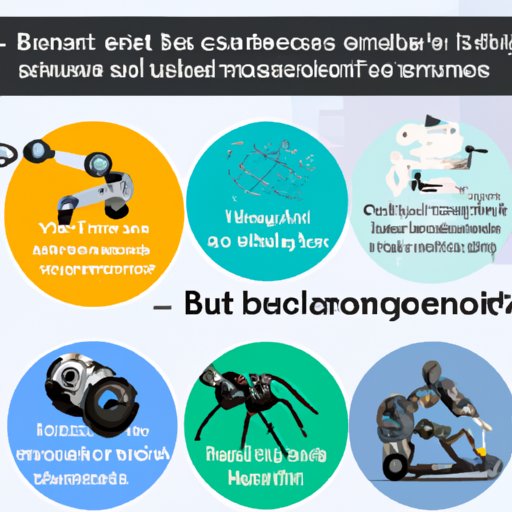Introduction
Soft robotics is a rapidly growing field of robotics that has the potential to revolutionize many industries. Soft robotics is the use of flexible materials, such as fabric and silicone, to create robots that are able to interact with their environment and adapt to changing conditions. Soft robots can be used in a variety of applications, from manufacturing to healthcare, and have the potential to transform traditional industry practices. This article will explore the basics of soft robotics, examine its applications and benefits, discuss the challenges and limitations of soft robotics, and look at how it is transforming manufacturing and industry.
A Beginner’s Guide to Soft Robotics: An Overview of the Basics
Soft robotics is an emerging field of robotics that involves the use of flexible materials and sensors to create robots that are able to interact and adapt to their environment. The term “soft robotics” was coined by Professor George Whitesides of Harvard University in 2007. He defined soft robotics as “robots made of soft materials, which can change shape in response to external stimuli, such as temperature or pressure.”
There are several types of soft robots, including pneumatically actuated robots, electro-active polymer robots, and magnetically actuated robots. Pneumatically actuated robots use air pressure to move and manipulate objects. Electro-active polymer robots are made of special materials that contract when exposed to electrical current. Magnetically actuated robots use magnetic fields to achieve movement. All of these technologies can be used to create robots that are capable of interacting with their environment in ways that rigid robots cannot.
The components of a soft robot typically include a controller, a power source, sensors, actuators, and a flexible material. The controller is responsible for controlling the robot’s movements, while the power source provides the energy needed for the robot to operate. Sensors provide feedback to the controller, allowing the robot to respond to its environment. Actuators convert electrical signals into movements. And the flexible material gives the robot its shape and allows it to interact with its environment.
Soft robots have several advantages over traditional rigid robots. They are more flexible, adaptable, and lightweight than rigid robots. They can also be easily customized for different tasks. However, there are some disadvantages to soft robots, as well. They are generally more expensive than rigid robots, and they are not as strong or durable as rigid robots.

Exploring the Applications and Benefits of Soft Robotics
Soft robotics have a wide range of applications, from manufacturing to healthcare. In manufacturing, soft robots can be used to handle delicate parts and materials, such as circuit boards and electronic components. In healthcare, soft robots can be used to assist in surgery, rehabilitation, and physical therapy. In the automotive industry, soft robots can be used to assemble car parts and perform other tasks. And in consumer electronics, soft robots can be used to test and inspect products before they are released to the market.
The benefits of soft robotics are numerous. Soft robots are more efficient than traditional robots, as they can quickly adapt to changes in their environment. They are also safer than rigid robots, as they are less likely to cause injury to humans or damage to equipment. Additionally, soft robots are more affordable than rigid robots, making them accessible to businesses of all sizes.

Examining the Challenges and Limitations of Soft Robotics
Although soft robotics offer many advantages, there are still some challenges and limitations that must be addressed. One of the biggest challenges is cost. Soft robots tend to be more expensive than traditional robots due to the cost of materials and components. Additionally, soft robots are not as flexible as rigid robots, which limits their ability to perform certain tasks. Finally, soft robots are not as durable as rigid robots, meaning they need to be replaced more often.
How Soft Robotics are Transforming Manufacturing and Industry
Soft robots are transforming manufacturing and industry in many ways. One of the most notable ways is through automation. Soft robots are able to automate processes that were once done manually, increasing efficiency and reducing labor costs. Additionally, soft robots are able to improve safety in manufacturing environments, as they are less likely to cause injury to humans or damage to equipment.
Soft robots are also improving efficiency in manufacturing processes. Soft robots are able to move faster and more accurately than traditional robots, allowing them to complete tasks in a fraction of the time. Furthermore, soft robots are able to work in tight spaces and around obstacles, making them ideal for complex tasks.

Innovations in Soft Robotics: What the Future Holds
The future of soft robotics is exciting, with many new innovations on the horizon. One of the most promising developments is the integration of artificial intelligence into soft robotics. AI-enabled soft robots will be able to learn from their environment, enabling them to make decisions and take action without human intervention. Additionally, advances in human-robot interactions are paving the way for soft robots to interact with humans in a more natural way.
Another area of innovation is adaptive robotics. Adaptive robots are able to adjust their behavior based on their environment, making them more versatile and efficient. Finally, soft robots are being developed to work in dangerous and extreme environments, such as deep sea exploration, hazardous waste cleanup, and space exploration.
Conclusion
Soft robotics is an exciting and rapidly evolving field of robotics that has the potential to revolutionize many industries. Soft robots offer many advantages over traditional rigid robots, including increased efficiency, improved safety, and greater flexibility. They are being used in a variety of applications, from manufacturing to healthcare, and are transforming traditional industry practices. As the technology continues to evolve, the possibilities for soft robotics are endless.
(Note: Is this article not meeting your expectations? Do you have knowledge or insights to share? Unlock new opportunities and expand your reach by joining our authors team. Click Registration to join us and share your expertise with our readers.)
